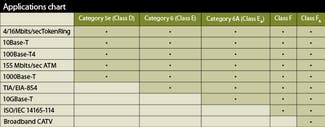Love necroing threads. Especially when it’s my first post.
I find this to be a fascinating topic. I don’t like the word “supports”. I think it’s misleading. A bridge rated at 5 tones could probably support a 10 ton load once in a while. I like to use the term “officially rated”.
I like the idea CCNA is teaching that 5e can “support” 10Gb. It causes you to critically think and dig deeper into ratings and how cables get them and what is required from a cable to carry a certain speed over a given distance.
Where is this so called “shielding” I hear so much about?
I’ve opened up rated 6 and 6a to find nothing more then a polymer membrane separating two pairs, or a few strands of plastic “string”. Where is this metal foil or mesh I hear so much about? Is the shielding from electronic interference coming from pixy dust?
I’ve opened up Cat5e to find individual each twisted pairs separated by a polymer core and wrapped in a foil jacket. Was that a company going hard 20 years ago before 6 was a standard? But clearly a foil wrap or mesh isn’t part of the standard because I have yet to open a 6 or 6a cable to find any such thing.
Also, Cat6 and Cat5e are indistinguishable. Don’t let the industry tell you different. How many people are going to loose their minds over that comment? Cat6a on the other hand…
Fun fact, most Cat5e is UL rated to 350MHz. The standard for 6 is 250. The standard for 6a is 500. 10Gh needs 500 for it’s full potential. So 6 isn’t even official “supported” for 10Gb.
Or, and here is where people are really going to loose their minds, if you say 6 can support 10Gb, then you have to say 5e does too.
Cat 6 only supports 10Gb speeds up to 55 meters.
6a is the full standard for 10Gb.
You see where I am going with this?
Bottom line being, I like to look for a UL rating for the cable. Not what Cat version it was branded with.
Disclaimer: I haven’t touched every make and model of every manufactures Cat5e through Cat6a. But the only cable I have yet to come across that actually had a metal foil or mesh jacket/shielding was 5e.
So, does 5e “support” 10Gb? No, but Cat cable rated above 250MHz does support 10Gb up to 55m runs.

